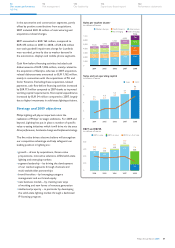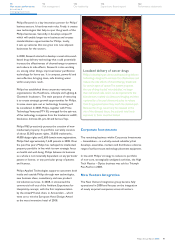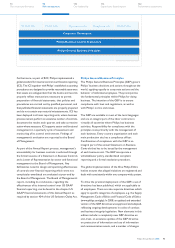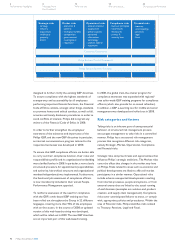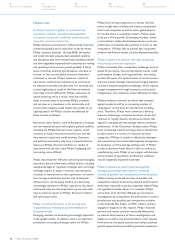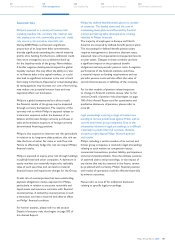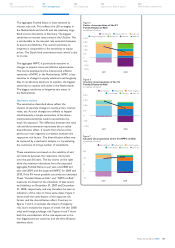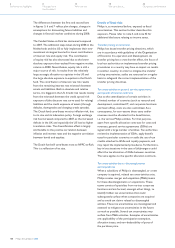Philips 2008 Annual Report Download - page 99
Download and view the complete annual report
Please find page 99 of the 2008 Philips annual report below. You can navigate through the pages in the report by either clicking on the pages listed below, or by using the keyword search tool below to find specific information within the annual report.
Philips’ global presence exposes the company to regional
and local regulatory rules which may interfere with the
realization of business opportunities and investments
in the countries in which Philips operates.
Philips has established subsidiaries in over 60 countries.
These subsidiaries are exposed to changes in governmental
regulations and unfavorable political developments, which
may limit the realization of business opportunities or
impair Philips’ local investments. An increased focus
on medical and health care increases the exposure to
highly regulated markets, where obtaining clearances
or approvals for new products is of great importance,
and the dependency on the funding available for healthcare
systems. In addition, changes in reimbursement policies
may affect spending on healthcare.
Operational risks
Failure to achieve improvements in Philips’ solution
and product creation process and/or increased speed in
innovation-to-market may hamper Philips’ profitable
growth ambitions.
Further improvements in Philips’ solution and product
creation process, ensuring timely delivery of new solutions
and products at lower cost and upgrading of customer
service levels to create sustainable competitive advantages,
are important in realizing Philips’ profitable growth
ambitions. The emergence of new low-cost players,
particularly in Asia, further underlines the importance
of improvements in the product creation process. The
success of new solution and product creation, however,
depends on a number of factors, including timely and
successful completion of development efforts, market
acceptance, Philips’s ability to manage the risks associated
with new products and production ramp-up issues,
the availability of products in appropriate quantities
and costs to meet anticipated demand, and the risk
that new products and services may have quality or
other defects in the early stages of introduction.
Accordingly, Philips cannot determine in advance
the ultimate effect that new solutions and product
creations will have on its financial condition and
operating results. If Philips fails to accelerate its
innovation-to-market processes and fails to ensure
that end-user insights are fully captured and translated
into solution and product creations that improve
product mix and consequently contribution, it may
face an erosion of its market share and competitiveness.
If Philips is unable to ensure effective supply chain
management, it may be unable to sustain its
competitiveness in its markets.
Philips is continuing the process of creating a leaner
supply base with fewer suppliers, while maintaining
dual sourcing strategies where possible. This strategy
strongly supports close cooperation with suppliers to
enhance, amongst others, time to market and quality.
In addition, Philips is continuing its initiatives to reduce
assets through outsourcing. These processes may result
in increased dependency. Although Philips works closely
with its suppliers to avoid supply-related problems,
there can be no assurance that it will not encounter
supply problems in the future or that it will be able to
replace a supplier that is not able to meet its demand.
Shortages or delays could materially harm its business.
Philips maintains a regular review of its strategic and
critical suppliers to assess financial stability.
Philips’ supply chain is also exposed to fluctuations
in energy and raw material prices. In recent times,
commodities such as oil have been subject to volatile
markets and subject to significant price increases from
time to time. If Philips is not able to compensate for
or pass on its increased costs to customers, such price
increases could have a material adverse impact on its
financial results.
Most of Philips’ activities are conducted outside of
the Netherlands, and international operations bring
challenges. For example, production and procurement
of products and parts in Asian countries are increasing,
and this creates a risk that production and shipping of
products and parts could be interrupted by a natural
disaster in that region.
A setback in global account management could hamper
expected growth.
Integral global key account management is important
for maintaining a sustainable competitive advantage.
An example of this is the provision of category
management solutions to key retailers for supporting
consumers in their decision-making. A setback in the
management of international key retail accounts could
hamper growth and damage Philips’ reputation and
brand image.
Due to the fact that Philips is dependent on its
personnel for leadership and specialized skills, the
loss of its ability to attract and retain such personnel
would have an adverse effect on its business.
The retention of talented employees in sales and
marketing, research and development, finance and
general management, as well as of highly specialized
technical personnel, especially in transferring technologies
to low-cost countries, is critical to Philips’ success.
The loss of specialized skills could also result in
business interruptions.
Philips Annual Report 2008 99
122
Performance statements
114
Supervisory Board report
110
Our leadership
94
Risk management
70
Our sector performance


